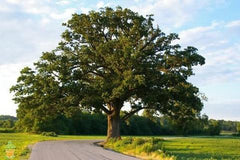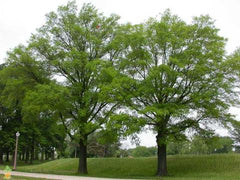Oak trees are treasured for their beauty strength, and longevity. Their stately presence graces landscapes with natural elegance. However waiting years for oak trees to reach maturity requires patience. If you want your oak to achieve its full glory faster, there are proven techniques to accelerate growth. With the proper care and conditions, it is possible to speed up your oak tree’s development significantly.
Choose a Fast-Growing Oak Species
There are over 60 oak species, and growth rates vary widely. Selecting a naturally fast-growing oak variety stacks the odds in your favor. Excellent choices include northern red oak pin oak, cherrybark oak and swamp chestnut oak. When young, they can expand over 2 feet per year. Slower species like white oak and live oak may only grow 6-12 inches annually. Match the oak species to your goals.
Provide Ideal Soil Conditions
Oak trees thrive in deep, nutrient-rich, well-drained soil. Improve the soil by amending it with compost or manure to increase fertility. A pH between 5-7 is optimal. Test the soil and add amendments like lime if needed to reach the ideal pH range. Ensure adequate drainage, as wet soil will inhibit oak growth.
Water Thoroughly and Consistently
Oaks need about 1-1.5 inches of water per week for robust growth. Target watering at the root zone and soak the ground slowly and deeply. Avoid frequent shallow watering. Consistency is vital, especially when trees are establishing. Don’t allow the soil to completely dry out.
Prune Judiciously
Pruning oak branches prompts faster growth of side shoots But only prune what is necessary, using proper technique Always cut just outside the branch collar at a 45° angle. Disinfect tools between each cut to prevent spreading disease.
Fertilize Strategically
Fertilizing supplies vital nutrients for growth. Apply a balanced organic or slow-release fertilizer in spring, spreading it over the root zone area without touching the trunk. Follow label rates. Boost nitrogen levels in the soil to spur leafy growth, but don’t over-fertilize.
Control Pests and Diseases
Oak tree growth declines when pests or diseases attack. Stay vigilant and take prompt action. Accurately identify any fungus, borers, mites, beetles, caterpillars, etc. Use integrated pest management and treat organically when possible.
Ensure Full Sun Exposure
Oak trees grow best with maximum sunlight. Limit shade from other trees. If planted too close together, thin surrounding trees to let in more light. Reflective surfaces can also inhibit growth. Avoid planting near reflective walls or objects.
Choose an Ideal Planting Site
Select a site with full sun exposure (at least 6 hours of direct sun daily) for fast oak growth. Well-draining soil is essential, as wet, compacted, or heavy clay soil will slow development. Improve drainage before planting if needed. Allow enough space for the oak’s mature size.
Prepare and Amend the Soil
Before planting, till compost, manure, or other organic matter into the soil to enrich and improve texture. Test drainage by digging a hole and filling it with water; it should drain completely in 8-12 hours. For best growth, oak trees prefer slightly acidic soil with a pH between 4.5-6.5.
Mulch Around the Tree
Mulching 2-4 inches deep from the trunk outward retains moisture and insulates roots. Organic mulch also improves soil as it decomposes. Maintain the mulch layer, replenishing as needed. Keep mulch several inches away from the trunk to avoid moisture buildup.
Water Deeply and Infrequently
Water young oaks thoroughly once or twice a week during dry periods. Soak the entire root zone, not just the surface. Deep weekly soakings are better than frequent light sprinklings. Reduce watering frequency as the tree establishes an extensive root system.
Fertilize in Early Spring
Apply a balanced, slow-release organic fertilizer or one formulated for oaks in early spring before growth resumes. Follow label directions carefully. Boost nitrogen levels to promote leafy growth. Excess fertilizer can damage roots.
Prune Only When Necessary
Avoid heavy pruning, which can stunt oak growth. Remove only dead, damaged or crossing branches using proper technique. Pruning side branches prompts faster growth below the cuts. Disinfect tools after each cut to prevent disease transmission.
Protect Against Pests and Diseases
Watch for signs of common oak pests like borers and mites. Identify diseases like oak wilt promptly. Maintain vigor through proper care. Organic pest control methods are preferable. Quick treatment of any problems prevents major damage.
Provide Sufficient Space
Allow enough room for the oak’s mature height and spread. Oaks often grow 2 feet or more per year when young and can eventually reach 60-100 feet tall. Planting too close hampers development. Give the oak space to grow freely.
Proper oak tree selection, abundant sunlight, fertile amended soil, adequate water, judicious pruning and pest control, and sufficient space will help your oak grow faster and reach its full potential sooner. With attentive care optimizing growth conditions, you can achieve a mature oak tree landscape more quickly.

My Cart Your Cart is empty
Oaks are fast growing and sturdy native shade trees. They are long-lived and can grow from 1 to 3 feet per year throughout their lifetime. They grow fastest in the first 10 or 15 years. Fast growing oak trees can easily grow 2 to 3 feet per year when they are young. Oak trees are widely used as street trees because they grow quickly and tolerate pollution. They make ideal shade trees if your yard can afford plenty of growing space. They grow quickly and add more to the surrounding environment than they take away. Read on to learn more about fast growing oak trees.
Types of Fast-Growing Oak Trees

The Northern Red Oak tree is a substantial, but beautiful tree. This tree is large; it can grow up to 75 feet tall and 45 feet wide. This red oak is a US native tree that provides wonderful environmental value. Its branches house birds and small mammals and its acorns feed an abundant variety of wildlife. The Northern Red Oak is extremely cold hardy. It can grow in USDA growing zones 3, 4, 5, 6, 7, and 8. The red autumn leaves are absolutely stunning.

This oak tree is native to the southeastern United States. It is sometimes called the spotted oak or the swamp red oak. The Shumard Oak can grow up to 80 feet tall, although it averages closer to 40 to 60 feet tall, and 40 feet wide at maturity. This fast growing oak tree is tough. It is incredibly adaptable and can grow in a variety of conditions, but is not as cold hardy as the Northern Red Oak tree.The Shumard Oak puts on a phenomenal fall display with vibrant reds and oranges.

Willow Oaks are fast growing oak trees that look different from other oak trees. Willow Oak trees have unique leaves that look similar to willow (salix) tree leaves. This shade tree is great for the ecosystem. It has a long lifespan and feeds and houses wildlife. Willow Oaks grow to 60 feet tall and 40 feet wide. If you have the space, this tree is great for adding shade to your yard. This oak tree has gorgeous gold and orange fall foliage.
These fast growing oak trees are very adaptable and easy to grow. Plant oak trees in full sun. Once they are established, oaks are maintenance free. They are drought, black walnut, and pollution tolerant. If your soil is nutrient weak, oak trees can be fed in spring with a balanced slow release fertilizer. This fertilizer can also be safely used at the time of planting to give your newly planted tree a boost.
I hope you enjoyed reading about fast growing oak trees. Happy planting!
You May Also Like:
Collections:
Blogs:
Arborist Gene Basler examines live oak 1 year after planting Proper Tree Care
FAQ
How do I get my oak tree to grow faster?
Generally, young trees can be fertilized to establish them quickly. Nitrogen is the primary nutrient of value to oaks. Prior to rain or irrigation, fertilizer can be spread on the ground to cover the outer two-thirds of the root zone. An alternate application method is sometimes useful.
How tall will an oak tree grow in 10 years?
In 10 years, an oak tree can grow to be about 12 to 20 feet tall, depending on the species and growing conditions.
What is the best fertilizer for oak trees?
ANSWER: A standard fertilizer should be fine. One landscaper I interviewed advised an 8-2-4 compost-based fertilizer, meaning 8% nitrogen, 2% phosphorus, and 4% potassium. Others weren’t so specific as to proportions, saying only “standard” or “regular.”
